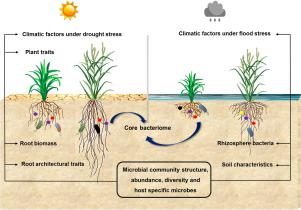Science of the Total Environment ( IF 8.2 ) Pub Date : 2021-01-17 , DOI: 10.1016/j.scitotenv.2021.145214 Gem Thomas-Barry , Chaney C.G. St. Martin , Michael D.J. Lynch , Adesh Ramsubhag , Judy Rouse-Miller , Trevor C. Charles

|
The natural variation of multiple abiotic stresses in hyper-seasonal edaphic savanna provides a unique opportunity to study the rhizobacteriome community structure of plants adapted to climate change-like conditions in the humid tropics. In this study, we evaluated changes in soil, plant and rhizobacteriome community structure parameters across seasons (wet and dry) in two edaphic savannas (SV-1 and SV-5) using four dominant plant species. We then examined relationships between rhizobacteriome community structure and soil properties, plant biomass, and conventional and novel root traits. We further hypothesized that plants adapted to the Aripo Savanna had a core rhizobacteriome, which was specific to plant species and related to root foraging traits. Our results showed that cation exchange capacity (CEC) and the concentration of micronutrients (Fe, Cu and B) were the only soil factors that differed across savanna and season, respectively. Plant biomass traits were generally higher in the dry season, with a higher allocation to root growth in SV-5. Root traits were more plastic in SV-5, and network length-distribution was the only root trait which showed a consistent pattern of lower values in the dry season for three of the dominant plant species. Rhizobacterial community compositions were dominated by Proteobacteria and Acidobacteria, as well as WPS-2, which is dominant in extreme environments. We identified a shared core rhizobacteriome across plant species and savannas. Cation exchange capacity was a major driver of rhizobacterial community assemblies across savannas. Savanna-specific drivers of rhizobacterial community assemblies included CEC and Fe for SV-1, and CEC, TDS, NH4+, NO3-, Mn, K, and network length-distribution for SV-5. Plant factors on the microbiome were minimal, and host selectivity was mediated by the seasonal changes. We conclude that edaphoclimatic factors (soil and season) are the key determinants influencing rhizobacteriome community structure in multiple stressed-environments, which are ecologically similar to the Aripo Savanna.
中文翻译:

影响植物的根际细菌群落结构的驱动因素适应多种气候胁迫的稀树草原。
季节性超大型热带稀树草原中多种非生物胁迫的自然变化为研究适应热带湿润气候条件的植物的根际细菌群落结构提供了独特的机会。在这项研究中,我们评估了使用两种优势植物的两个热带稀树草原(SV-1和SV-5)在不同季节(干湿)下土壤,植物和根瘤菌群落结构参数的变化。然后,我们检查了根瘤菌群落结构与土壤特性,植物生物量以及常规根系和新根系之间的关系。我们进一步假设适应Aripo Savanna的植物具有核心的根际细菌基因组,该核心根瘤菌特定于植物物种,并且与根觅食性状有关。我们的结果表明,阳离子交换容量(CEC)和微量营养素(Fe,Cu和B)是唯一在整个稀树草原和整个季节不同的土壤因子。在干旱季节,植物生物量性状通常较高,而对SV-5根系生长的分配较高。SV-5的根性状更具可塑性,并且网络长度分布是唯一一种在干旱季节对三种优势植物物种表现出一致的较低值模式的根性状。根际细菌的组成主要由变形杆菌和酸性细菌以及WPS-2主导,WPS-2在极端环境中占主导地位。我们确定了跨植物物种和热带稀树草原共享的核心根瘤菌。阳离子交换能力是整个热带稀树草原根瘤菌群落组装的主要驱动力。稀疏菌特定的根瘤菌群落驱动因子包括SV-1的CEC和Fe,以及CEC,TDS,NH 在干旱季节,植物生物量性状通常较高,而对SV-5根系生长的分配较高。SV-5的根性状更具可塑性,并且网络长度分布是唯一一种在干旱季节对三种优势植物物种表现出一致的较低值模式的根性状。根际细菌的组成主要由变形杆菌和酸性细菌以及WPS-2主导,WPS-2在极端环境中占主导地位。我们确定了跨植物物种和热带稀树草原共享的核心根瘤菌。阳离子交换能力是整个热带稀树草原根瘤菌群落组装的主要驱动力。稀疏菌特定的根瘤菌群落驱动因子包括SV-1的CEC和Fe,以及CEC,TDS,NH 在干旱季节,植物生物量性状通常较高,而对SV-5根系生长的分配较高。SV-5的根性状更具可塑性,并且网络长度分布是唯一一种在干旱季节对三种优势植物物种表现出一致的较低值模式的根性状。根际细菌的组成主要由变形杆菌和酸性细菌以及WPS-2主导,WPS-2在极端环境中占主导地位。我们确定了跨植物物种和热带稀树草原共享的核心根瘤菌。阳离子交换能力是整个热带稀树草原根瘤菌群落组装的主要驱动力。稀树草原特定的根瘤菌群落驱动因子包括SV-1的CEC和Fe,以及CEC,TDS,NH SV-5的根性状更具可塑性,并且网络长度分布是唯一一种在干旱季节对三种优势植物物种表现出一致的较低值模式的根性状。根际细菌的组成主要由变形杆菌和酸性细菌以及WPS-2主导,WPS-2在极端环境中占主导地位。我们确定了跨植物物种和热带稀树草原共享的核心根瘤菌。阳离子交换能力是整个热带稀树草原根瘤菌群落组装的主要驱动力。稀疏菌特定的根瘤菌群落驱动因子包括SV-1的CEC和Fe,以及CEC,TDS,NH SV-5的根性状更具可塑性,并且网络长度分布是唯一一种在干旱季节对三种优势植物物种表现出一致的较低值模式的根性状。根际细菌的组成主要由变形杆菌和酸性细菌以及WPS-2主导,WPS-2在极端环境中占主导地位。我们确定了跨植物物种和热带稀树草原共享的核心根瘤菌。阳离子交换能力是整个热带稀树草原根瘤菌群落组装的主要驱动力。稀疏菌特定的根瘤菌群落驱动因子包括SV-1的CEC和Fe,以及CEC,TDS,NH 根际细菌的组成主要由变形杆菌和酸性细菌以及WPS-2主导,WPS-2在极端环境中占主导地位。我们确定了跨植物物种和热带稀树草原共享的核心根瘤菌。阳离子交换能力是整个热带稀树草原根瘤菌群落组装的主要驱动力。稀疏菌特定的根瘤菌群落驱动因子包括SV-1的CEC和Fe,以及CEC,TDS,NH 根际细菌的组成主要由变形杆菌和酸性细菌以及WPS-2主导,WPS-2在极端环境中占主导地位。我们确定了跨植物物种和热带稀树草原共享的核心根瘤菌。阳离子交换能力是整个热带稀树草原根瘤菌群落组装的主要驱动力。稀疏菌特定的根瘤菌群落驱动因子包括SV-1的CEC和Fe,以及CEC,TDS,NH4 +,NO 3 - ,锰,钾,以及网络长度分布SV-5。微生物组中的植物因子极小,宿主选择性是由季节变化介导的。我们得出的结论是,在多种胁迫环境中,生态环境因素(土壤和季节)是影响根际细菌群落结构的关键决定因素,生态环境与Aripo Savanna相似。





















































 京公网安备 11010802027423号
京公网安备 11010802027423号